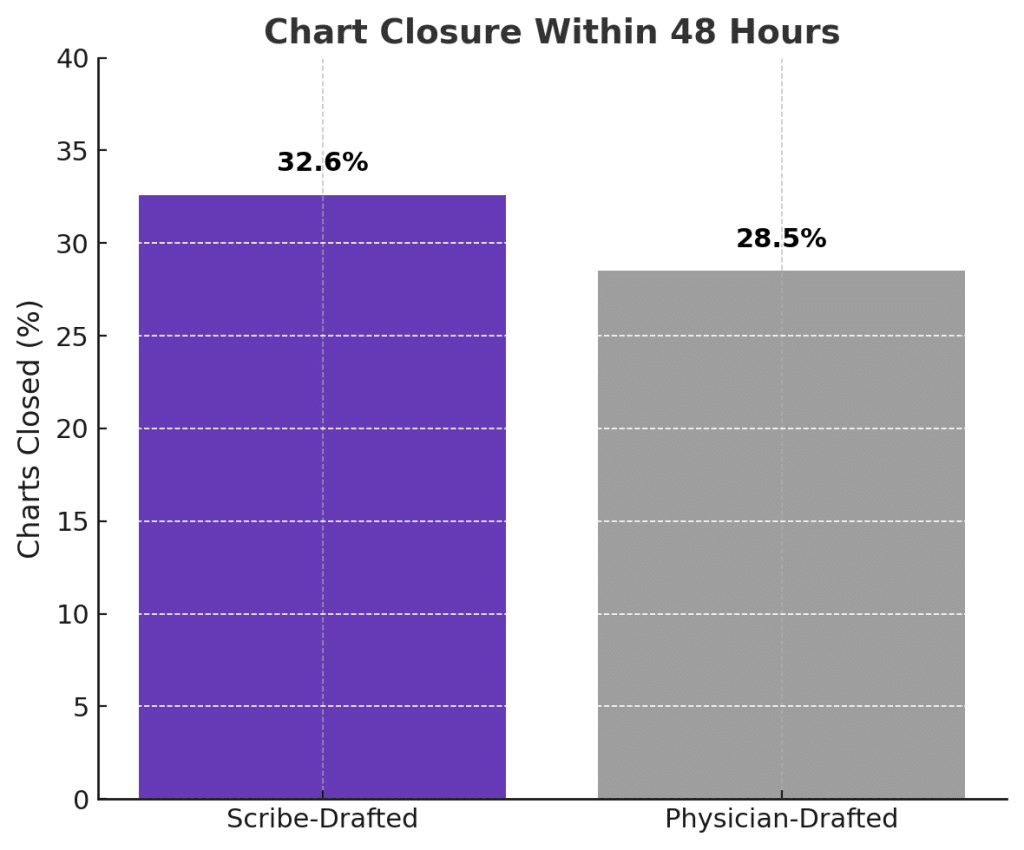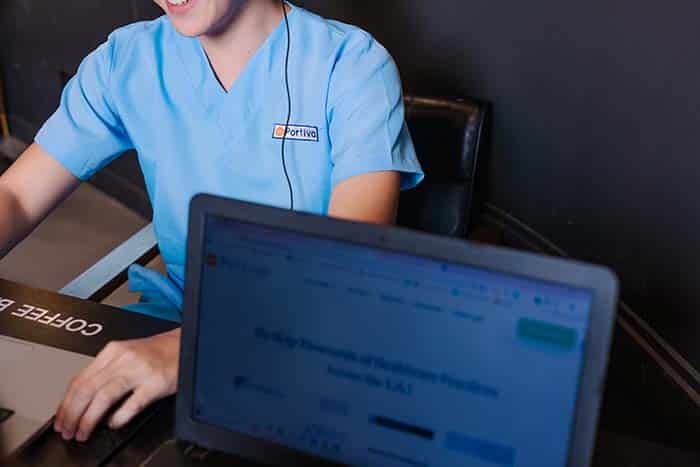What Does a Medical Scribe Do? A Full Breakdown of This Critical Role
Want to improve patient care and reduce physician burnout? Discover what does a medical scribe do and how they streamline documentation and boost efficiency.
How Can Prior Authorization Remote Help Your Practice?
See how Portiva is making a real difference in medical practices through our clients’ experiences. Watch this short video to see the impact for yourself, and let’s talk about how we can help streamline your operations and improve patient care today!
Table of Contents
When you walk into a clinic or hospital for a check-up or emergency, you’re likely to meet not just a physician. Still, a behind-the-scenes professional who ensures your visit is accurately recorded and seamlessly managed. This professional is known as a medical scribe. If you’ve ever wondered, what does a medical scribe do, the answer lies in their crucial role supporting both doctor and patient in real time—particularly through accurate documentation in the electronic health record system. But why is this role becoming essential in today’s fast-paced healthcare environment?
This guide’ll explain everything you need about the medical scribe role, from day-to-day tasks to required qualifications and career opportunities.
The Core Responsibilities of a Medical Scribe
A medical scribe works alongside medical professionals during patient visits, capturing detailed notes in real time into the electronic health record (EHR) system. Scribes are trained to understand medical terminology, anatomy, and documentation requirements to accurately reflect the physician’s assessments, treatments, and plans.
Their primary responsibilities include:
- Documenting the patient’s visit from start to finish
- Entering information into the electronic health records
- Recording patient care decisions and care plans
- Tracking patient interactions, lab orders, and prescriptions
- Supporting the physician by handling clerical duties and reducing their documentation burden
Scribes essentially act as a personal assistant to the doctor, managing the back-end of the visit so that the physician can focus entirely on the patient. Their ability to document swiftly, handle records, and track care plans makes them indispensable in today’s healthcare settings.
Why Medical Scribes Matter in Healthcare
As the demand for detailed documentation has increased across the healthcare industry, physicians are burdened with more time in front of a computer than with patients. Studies have shown that providers may spend up to twice as much time entering data as they do in direct patient care.
This is where medical scribes step in to restore the balance. By taking on the task of medical scribing, they help:
- Improve patient care by allowing doctors to engage more directly with patients
- Speed up emergency department workflow
- Ensure accurate and comprehensive medical records
- Enhance physician satisfaction and reduce burnout
According to the American Medical Association and a study published in the Annals of Internal Medicine, integrating medical scribes can increase physician productivity and reduce patient wait times [1].
What Our Clients Say About Us!
Discover how our dedicated clients have achieved their goals and transformed their businesses with our expert solutions. Join the ranks of satisfied customers and experience the difference for yourself.
Boost your Efficiency with
Portiva's Virtual Medical Assistant Services
Portiva’s Virtual Medical Assistant Services help healthcare providers streamline administrative tasks, improve efficiency, and enhance patient care all while reducing workload and costs.
Medical Assistant
Insurance Verification
Medical Receptionist
Prior Authorization
Medical Scribe
Dental Assistant
Medical Transcription
Executive Assistant
Medical Billing
Medical Billing
Where Do Medical Scribes Work?
Medical scribes are employed across a range of settings:
- Hospitals
- Clinics
- Emergency rooms
- Emergency departments
- Outpatient specialty centers
Scribes are especially valuable in high-pressure environments like emergency departments, where physicians must quickly see many patients. Having a scribe ensures that nothing is missed during a patient’s visit.
Skills and Qualifications of a Medical Scribe
You don’t need a medical degree to become a medical scribe, but there are essential skills and qualifications you must have:
- A high school diploma (minimum requirement)
- Excellent computer skills and typing skills (often 60+ WPM)
- Firm grasp of healthcare terms
- Ability to multitask during patient encounters
- Good verbal communication skills and attention to detail
- Comfortable working in fast-paced environments like emergency rooms
Many medical scribe training pathways provide comprehensive training that covers healthcare expertise, documentation protocols, and electronic medical record software usage.
Is Medical Scribing a Good Experience for Aspiring Healthcare Providers?
Yes, and it’s one of the most compelling reasons many students consider this job.
Medical scribing is an ideal stepping stone for those considering careers as:
- Physicians
- Physician assistants
- Nurses
- Other roles in the medical field
It provides firsthand exposure to patient interactions, medical decision-making, and the daily routine of healthcare providers. For those on a medical school track, it offers unmatched shadowing experience and a deeper understanding of medicine.
A Day in the Life of a Medical Scribe
A typical shift begins with logging into the EHR system and preparing for the day’s schedule. The scribe works in tandem as doctors see patients, documenting everything from symptoms and diagnoses to test results and follow-up instructions.
Scribes may:
- Join rounds in hospitals
- Follow a physician in a clinic
- Document critical care in emergency departments
- Communicate with other departments for lab and imaging follow-up
Depending on the provider, some scribes work directly in exam rooms, while others work remotely, listening in via secure systems.
What Is the Average Salary of a Medical Scribe?
The average salary for a medical scribe ranges from $13 to $20 per hour, depending on location, experience, and employer. Entry-level positions may start at minimum wage, while seasoned scribes or those in leadership roles may earn more.
Some companies hire scribes as full-time employees, while others offer part-time or per-diem roles. For students looking to enter medical school, the value of the role goes beyond pay, offering crucial medical field exposure.
How to Become a Medical Scribe
If you’re interested in becoming a medical scribe, follow these steps:
- Earn your high school diploma
- Build essential skills: Improve typing speed, learn diagnostic terms, and refine your computer skills.
- Join a scribe program
- Apply for jobs in hospitals, clinics, and emergency rooms
Whether aiming for medicine, physician assistant school, or just seeking to enter the healthcare industry, medical scribing is an effective, accessible career launchpad.


In-person scribes led to a 10.5% increase in RVUs, an 8.8% rise in patients seen per hour, 57% more time spent with patients, and a 27% decrease in computer time. Chart closure within 48 hours improved from 28.5% (physicians) to 32.6% (scribes). Patient satisfaction remained high, and physicians reported greater satisfaction, especially when scribes assisted with clinical tasks and paperwork.
What Makes a Good Medical Scribe?
A good medical scribe is more than just a fast typist. They must:
- Understand medical knowledge and the flow of care
- Remain invisible during patient encounters, yet capture all necessary details
- Adapt to various physician styles and preferences
- Work under pressure without sacrificing accuracy
Most importantly, they contribute to patient care by enabling doctors to be more present and effective.
Final Thoughts: Why the Medical Scribe Role Matters
Medical scribes are transforming how documentation fits into healthcare. By handling the behind-the-scenes workload, scribes ensure physicians spend more time treating patients and typing less.
This isn’t just a benefit to doctors — it directly improves patient care, lowers wait times, and leads to more accurate patient records.
If you’re passionate about the medical field, possess strong computer skills, and want to gain experience before medical school, becoming a medical scribe is a strategic and rewarding career move.
This guide’ll explain everything you need about the medical scribe role, from day-to-day tasks to required qualifications and career opportunities.




